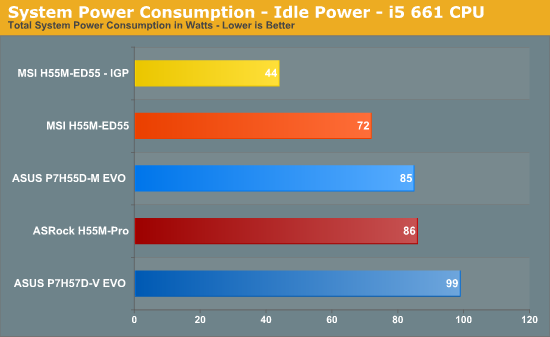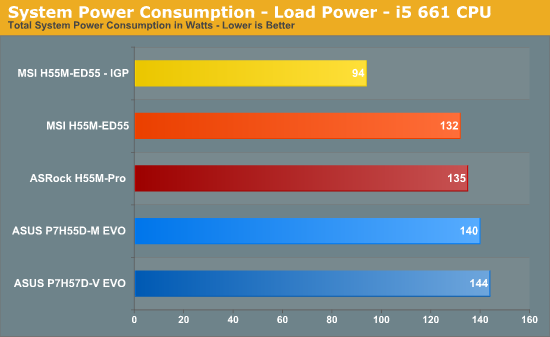Choosing the Best H55/H57 Motherboard - Part 1
by Rajinder Gill on January 31, 2010 11:30 PM EST- Posted in
- Motherboards
Testbed Setup and Power
| Testbed Setup - Overclocking / Benchmark | |
| Processor | Intel Core i5 661 ES CPU - 3.33GHz - 2 Cores 4 Threads, 4MB Cache |
| CPU Voltage | Various |
| Cooling | Intel air cooler Heatkiller 3.0 waterblock PA120.2 radiator and DDC ultra pump (with Petra top) 1/2 ID tubing for watercooling |
| Power Supply | Corsair HX950 |
| Memory | Corsair Dominator CMD8GX3M4A1600C8 1600MHz 8GB kit G.Skill Perfect Storm 8-8-8-24 2200MHz 4GB kit Corsair Dominator GT 8-8-8-24 2200MHz 4GB kit (X2 for 8GB) |
| Memory Settings | Various |
| Video Cards | MSI 275 Lightning (stock clocks) |
| Video Drivers | nVidia 195.62 WHQL |
| Hard Drive | Western Digital 7200RPM 1TB SATA 3/Gbps 32MB Buffer OCZ Vertex 120GB SSD |
| Optical Drives | Plextor PX-B900A Toshiba SD-H802A |
| Case | Open Test Bed - Dimastech Benching Station Lian-Li V2110 |
| Operating System | Windows 7 64 bit |
| . | |
We utilized memory kits from Corsair and G.Skill to verify memory compatibility on our test boards. Our OS and primary applications are loaded on the OCZ Vertex 120GB SSD drive and our games operate off the WD Caviar Black 1TB drive. We did a clean install of the OS and applications for each motherboard.
We used Intel's stock cooler for the stock comparison testing, while water-cooling via the superlative Heat Killer 3.0 water block was utilized for overclocking. For graphics duty, we used MSI's GTX 275 Lighting GPU to provide performance comparisons between boards during gaming benchmarks.
For our test results we set up each board as closely as possible in regards to memory timings. Otherwise all other settings are left on auto. The P55 utilized 8GB of DDR3 (apart from DFI's MI-T36 which is limited to 4GB), while the X58 platform contained 6GB. The P55 and X58 DDR3 timings were set to 7-7-7-20 1T at DDR3-1600 for the i7-920 and i7-870 processors at both stock and overclocked CPU settings.
We used DDR3-1333 6-6-6-18 1T timings for the i5-750 stock setup for all system benchmarks (non-gaming tests) as DDR3-1600 is not natively supported at a stock BCLK setting of 133.
For our Clarkdale i5 661 CPU, we used 7-7-7-20 1N timings at DDR3-1333MHz with 8GB of memory. We would have preferred to use CAS 6 timings to match our Lynnfield setup, but it seems 8GB of memory at CAS 6 on Clarkdale is not possible right now. The 4GHz gaming results used 8GB of memory at DDR3-1200 with CAS 6-6-6-18 1N timings to allow a BCLK of 200MHz with the QPI ratio in sync with CPU frequency.
There's little to separate these boards when you run them at a fixed frequency, showing nothing more than a 1-2% swing in most instances, which goes completely unnoticed in real world usage.
Power consumption
Our power consumption testing utilizes the same batch of components under similar circumstances in a bid to monitor variances between idle and CPU load conditions using an AC wall meter for power consumption measurements. We install the vendor supplied power saving utilitites on each board and enable power saving modes that don't involve any kind of underclocking or CPU core frequency modulation in order to run an apples to apples comparison.
Assuming a maximum 150w load in the worst case scenario, actual motherboard power consumption is around 15%~17% lower than the shown figures if you factor out switching losses at the PSU.


MSI continues in its dominance of idle/light load power saving performance by using buck controllers that support low switching speeds and allow phases to be turned off in light load conditions.
A graphics card like nVidia's 275 will add around 28w of idle power consumption to a Clarkdale system. It is unfortunate that Intel (and board vendors) do not offer drivers/GPU power management that allow a discrete GPU to be powered on/off on demand - the power savings would be rather attractive.
Note that most of the CPU VCC power saving features on these boards need to be turned off when overclocking to ensure system stability and to prevent PWM burnouts under modulating loads at higher levels of current draw. With power saving features switched off, you get a 5~10W increase in the idle power consumption at the same operating frequency, while load power consumption remains roughly the same due to current loading.










56 Comments
View All Comments
Rajinder Gill - Monday, February 1, 2010 - link
Hi,For i3 530 results, you can compare the i3~i5 deltas in Anand's coverage here;
http://www.anandtech.com/cpuchipsets/showdoc.aspx?...">http://www.anandtech.com/cpuchipsets/showdoc.aspx?...
That gives as a basic idea of what to expect. The actaul IGP consumption variance from board to board will be aroud 10~15w I'd expect. I can run some fo this stuff in the follow up.
regards
Raja
hyvonen - Monday, February 1, 2010 - link
Hi Raja,The MSI H55M-ED55 looks awesome for low-power HTPC, but the lack of undervolting is an incomprehensible miss on MSI's part. If they are as gung-ho about low-power as they claim, they should most definitely offer undervolting too.
Could you guys suggest to MSI that they should add undervolting options to their future BIOS releases? I know Anand's team has a lot of influence on manufacturers, and this could really help out MSI and their customers alike.
Rajinder Gill - Monday, February 1, 2010 - link
Sure thing, I'll pop it in a message to them.regards
Raja
hyvonen - Tuesday, February 2, 2010 - link
Thanks - this is much appreciated.YellowWing - Monday, February 1, 2010 - link
Thanks for the link to Anand article, but all of his power figures are for a machine using a graphics adapter. The i5-661 and i3-530 clock the graphics at different rates. So... imho it would be ideal to see idle and load figures for the i3-530.hyvonen - Monday, February 1, 2010 - link
SilenPCReview has a pretty good review on i5-661, where the system is configured for HTPC purposes (i.e., IGP & superlow power). They even touch on PSU efficiency at low power levels (the efficiency is pretty awful, even for a 450W 80plus PUS).http://www.silentpcreview.com/intel-clarkdale">http://www.silentpcreview.com/intel-clarkdale
I've already decided to go with a PicoPSU that should give me about 80% efficiency at 20-30W idle.
hyvonen - Monday, February 1, 2010 - link
Oh, and I wanted to point out that i5-661 was idling at extremely low power levels in that review. Moreover, I've seen another review somewhere comparing i5-661s and actual i3-530s - in that review, the i3-530 idle power was higher! My guess is that the idle power levels are so low in both that it's all within measurement noise.nuudles - Monday, February 1, 2010 - link
Hi Anand,Any news on when we will start seeing mini-ITX H55/57 boards? With more and more mATX boards mini-ITX is becoming the mATX of a couple of years ago.
I know that there is one DFI mini-ITX p55 board at Newegg, but it is $147 with shipping, plus something like a i3 530 would be an ideal match for a mini-ITX H55 for a very small + low power system (HTPC, etc).
Or if you add a small-ish video card like a 5750 then you have a nice and small (non-hardcore) gaming system.
Thanks!
Rajinder Gill - Monday, February 1, 2010 - link
Hi,We expect some of these vendors to have M-ITX boards somewhere over the next few months (hopefully).
Zotac have a H55 model that should be on sale soon:
http://pden.zotac.com/index.php?page=shop.product_...">http://pden.zotac.com/index.php?page=sh...mp;optio...
Nothing concrete yet from the big players in terms of release dates/models etc unfortunately.
regards
Raja
AstroGuardian - Monday, February 1, 2010 - link
Hello Raja and everyone:Would you be so kind and point me to a site or anything that has Intel and AMD chips compared? Live Lynnfield vs Clarkdale vs everything?
I have been into hardware for a loooong time but i was doing some science work lately and i am out of grip with latest chips.
Thanks everybody. This review was great